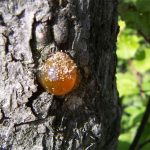 Hardened exudate from a wounded stem or leaves that is soluble in water.
Hardened exudate from a wounded stem or leaves that is soluble in water.
Substances that can disperse in water to form a viscous mucilaginous mass. They may be extracted from seeds, plant sap, and seaweeds, or they may be made from starch or cellulose. Most (apart from dextrins) are not digested and have no food value, although they contribute to the intake of non-starch polysaccharides.
Class of water-soluble colloidal substances that are exuded by plants.
“True” gum is little used in perfumery; being virtually odorless. However, the term “gum” is often applied to “resins.” especially with relation to turpentines, as in the Australian “gum tree.” Strictly speaking, gums are natural or synthetic water-soluble materials, such as gum arable.
In dentistry, the dense, fibrous tissue, covered by mucous membrane that envelops the alveolar processes of the upper and lower jaws and surrounds the necks of the teeth.
The soft tissue covering the part of the jaw which surrounds the teeth.
The pink, soft tissue in the mouth that surrounds the teeth. The gum is medically called the gingiva. Healthy gums are firm and pale pink and do not bleed easily. If bacteria build up under the gums, a substance called plaque forms that can ultimately pull the gum away from the teeth. Careful, regular brushing and flossing are needed to avoid gum disease.
The soft tissue surrounding the teeth. Also called the gingiva, this tissue protects underlying structures and helps to keep the teeth tightly in the jawbones. Inflammation of the gum is called gingivitis and may be due to dental plaque or to systemic disorders such as leukaemia and scurvy.
A resinous substance given off by or extracted from certain plants. It is sticky when moist but hardens on drying. Roughly, gum is any resin-like substance produced by plants.
A multifaceted polysaccharide of fluctuating composition, has the propensity to enlarge in aqueous solutions, leading to the formation of a gel or a thick viscous solution.
Various trees and plants produce a sticky substance that is highly valued for its unique properties in cookery and medicine. There are two main types of this substance that are commonly used in cooking: gum arabic and gum tragacanth. Gum arabic is obtained from certain species of acacia that are native to Arabia and India, and is frequently used in the production of confections such as jujubes, pastilles, and gumdrops. It is also used in medicine for its binding and emulsifying properties. Gum tragacanth, on the other hand, is derived from a spiny shrub that is primarily grown in western Asia. This type of gum is especially useful for thickening creams, gelatins, and pastes, and was once widely used in the production of special stiff royal icing that was used to make ornamental decorations for wedding cakes and other desserts. Whether used in cooking or medicine, these gums are highly valued for their unique properties and play an important role in a wide range of culinary and medicinal applications.
The soft tissue surrounding the teeth serves to safeguard the underlying structures and maintain the teeth securely in their positions within the jaw.
Healthy gums have a pink or brown color and possess a firm texture. Maintaining proper oral hygiene is essential for keeping the gums clean and preventing disease. If plaque is allowed to accumulate around the base of the teeth, it can lead to gingivitis, an early stage of gum disease characterized by inflammation of the gums. Gingivitis is reversible with timely intervention. However, if left untreated, it may progress into chronic periodontitis, an advanced gum disease that results in the formation of infected pockets between the gums and the teeth.
Bleeding gums usually indicate gingivitis, but in rare cases, they can be a result of leukemia or scurvy (caused by vitamin C deficiency). Gingival hyperplasia, which is the thickening of the gums, is most commonly observed as a side effect of phenytoin treatment, an anticonvulsant drug.
The soft tissue that envelopes the necks of the teeth and the areas of the jaws where the teeth are anchored. Also known as gingiva.
